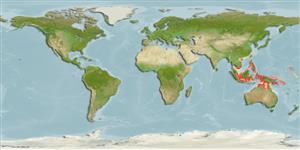>
Acanthuriformes (Surgeonfishes) >
Ephippidae (Spadefishes, batfishes and scats)
Etymology: Rhinoprenes: Greek, rhinos = nose + Greek, prenes = the front part of a body (Ref. 45335).
Environment: milieu / climate zone / depth range / distribution range
Ecologia
marino; salmastro demersale. Tropical
Western Pacific: Papua New Guinea to northern Australia.
Size / Peso / Age
Maturity: Lm ? range ? - ? cm
Max length : 15.0 cm TL maschio/sesso non determinato; (Ref. 245)
Spine dorsali (totale): 8; Raggi dorsali molli (totale): 19-20; Spine anali 3; Raggi anali molli: 16 - 17. Body deep and compressed, quadrangular in outline. Mouth small and inferior. Second dorsal spine, fourth pectoral ray, and first pelvic ray greatly prolonged into free filaments which reach tail base or beyond. First dorsal-fin spine, fourth pectoral-fin ray, and first pelvic-fin ray greatly elongated filaments, reaching to or beyond vertical line at rear end of dorsal-and anal-fin bases. Head naked. Mouth inferior, the snout and upper jaw projecting in front of lower jaw (Ref 43039).
Feeds on algae and sewage (Ref. 4537).
Life cycle and mating behavior
Maturità | Riproduzione | Deposizione | Uova | Fecundity | Larve
Nelson, J.S., 1984. Fishes of the world. 2nd edition. John Wiley & Sons, Inc., New York. 523 p. (Ref. 245)
IUCN Red List Status (Ref. 130435)
Threat to humans
Harmless
Human uses
Pesca: di nessun interesse
Informazioni ulteriori
Nomi ComuniSinonimiMetabolismoPredatoriEcotossicologiaRiproduzioneMaturitàDeposizioneSpawning aggregationFecundityUovaEgg development
BibliografiaAcquacolturaProfilo di acquacolturaVarietàGeneticaElectrophoresesEreditarietàMalattieElaborazioneNutrientsMass conversion
CollaboratoriImmaginiStamps, Coins Misc.SuoniCiguateraVelocitàModalità di nuotoArea branchialeOtolithsCervelliVista
Strumenti
Special reports
Download XML
Fonti Internet
Estimates based on models
Preferred temperature (Ref.
123201): 26.9 - 28.8, mean 28 °C (based on 232 cells).
Phylogenetic diversity index (Ref.
82804): PD
50 = 1.0000 [Uniqueness, from 0.5 = low to 2.0 = high].
Bayesian length-weight: a=0.02692 (0.01137 - 0.06373), b=2.94 (2.74 - 3.14), in cm total length, based on LWR estimates for this (Sub)family-body shape (Ref.
93245).
Trophic level (Ref.
69278): 2.0 ±0.00 se; based on food items.
Resilienza (Ref.
120179): Alto, tempo minimo di raddoppiamento della popolazione meno di 15 mesi (Preliminary K or Fecundity.).
Fishing Vulnerability (Ref.
59153): Low vulnerability (10 of 100).
